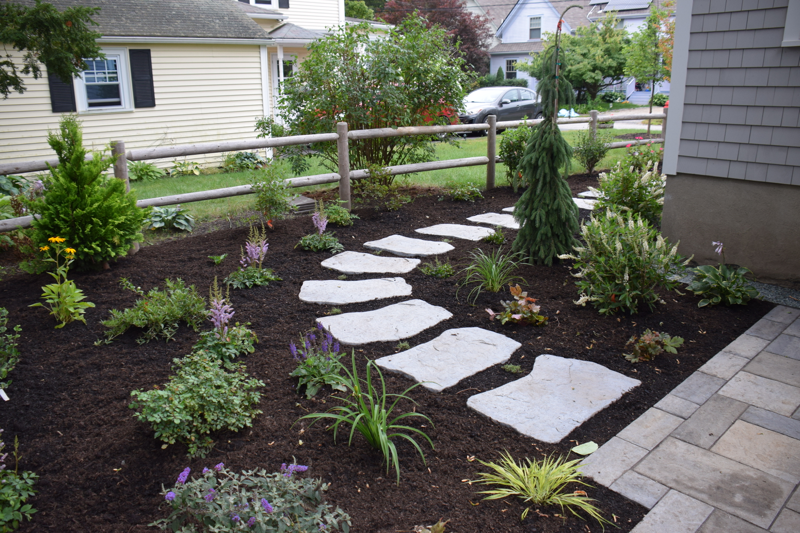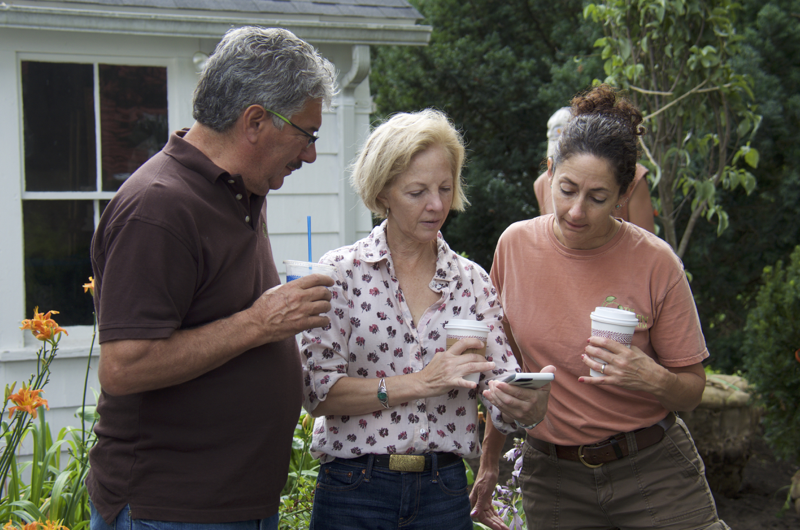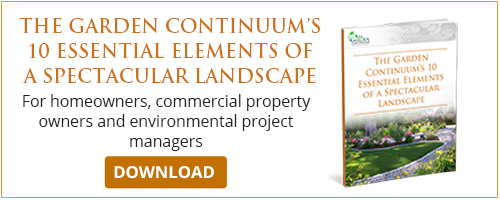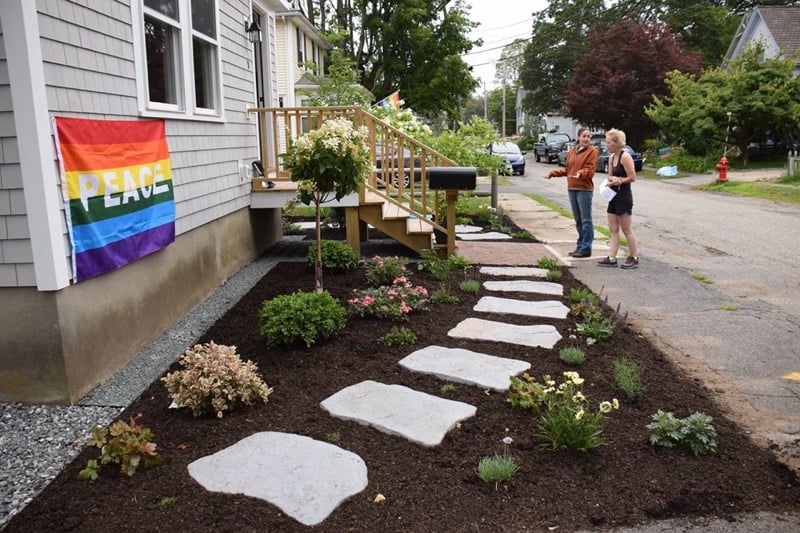Do you have a small space to landscape? That doesn’t mean you can’t think big. Many homeowners today find themselves working with smaller lots and bigger houses, often leaving them with relatively tiny areas to landscape. Frustrated by the lack of space, some simply give up thinking that they can turn their property into something fun and functional. Others, faced with a compact space, settle for a boring solution because they mistakenly believe that only rich people can afford to turn an uninspiring space into something beautiful and usable. Neither attitude could be further from the truth.
Follow these 5 steps to design your compact landscape
- Analyze the space you have - house walls, property lines, land and trees
- Plan your circulation flow - how do you get in, get out, and flow through
- Layout the hang out spaces - rest, relax, play, and entertain
- Select the structural materials - don’t shy away from high end choices
- Choose your plants - keep it simple, think vertical, and ease of pruning
All spaces have the potential to be highly functional and beautiful. The trick is to consider the relationship between the space (the form) and your use of that space (the function). Any outside space has to have a direct and functional connection with your house and the potential use of the space. You don’t want it to be isolated.
1. Analyze the space you have - house walls, property lines, land and trees
So how do you integrate form and function to achieve a beautiful yet useful landscape? Think first about the underlying structure of the space – is it wet or dry? Flat or rolling? Earthy or rocky? Symmetrical or asymmetrical? How can you reasonably use that space?
Often people make the mistake of thinking about plants first. Yes, of course plants are important, but many homeowners and even professional landscapers start off on the wrong foot by thinking about where they can put plants without first considering the underlying structure of the space. It is more important to think about the functionality of the space and what it “wants,” especially in small areas where there is little room for error. Big spaces can be a lot more forgiving of landscaping mistakes because there is plenty of room for trial-and-error. Keep in mind that considering landscape form and function first over flora does not diminish the value of plants, it simply puts them in proper sequence.
2. Plan your circulation flow - how do you get in, get out, and flow through
Once you have gained an intimate understanding of your area’s topography, you will begin to see how the details of the land will drive the landscape design. But first you have to be aware of how your house interfaces with the land and how every nook and cranny of the land interfaces with your property lines and your neighbor’s property. All of these relationships place constraints upon your landscape design, so it’s critical to understand them.
Existing natural and built elements play a huge role in your design and point out potential challenges to it that must be overcome. Where are the big trees? Are there rocks and water that must be taken into account? Where are the walkways, driveway, patio or deck? How are the windows situated in your house? Discover all of the constraints first because they will highlight any problems that must be solved.
All good landscape designs are based on one key aspect: movement. That movement is broken into three elements: access, egress, and circulation -- how you enter a space, move around in it, and exit it.

Taking a hard turn around a tight corner can be made graceful with wide steppers and plants that will soften the flow as they fill in.
3. Layout the hang out spaces - rest, relax, play, and entertain
The reason this is so important is because every square foot is crucial in a small space. If you have a narrow area to work with, you want to make sure you design around that constraint to avoid making it feel cramped as you move through it. Decide the flow of movement first, then think about where you want to rest and hang out. Once you determine that, you can adjust the flow of the space based on sun, shade, and season -- what is it like in the spring and fall? Will I go out there in the winter? Think about it in every season of use and how that use might change from season to season.
4. Select the structural materials - don’t shy away from high end choices
Now that you’ve carefully considered constraints, circulation, and areas of rest and relaxation, you can begin thinking about materials, starting with hardscape elements such as patio and wall materials, even furniture. One of the many benefits of a small space is that it provides an opportunity to use higher-end, more expensive materials for key areas because you’ll need less of it. So instead of choosing concrete or pavers you might choose granite or a local stone like Goshen stone which is local in our area. Instead of using pressure treated wood, you could choose a sustainably harvested wood. You can find a list of certified woods on The Forest Stewardship Council (FSC). You don’t have to bust your budget on every element – select one or two things that will be focal points in your small space. Give yourself the gift of living a little better.
5. Choose your plants - keep it simple, think vertical, and ease of pruning
And finally we get to plants. Plants are what brings life to a space and pulls at our heartstrings. In small spaces you are limited horizontally, so think vertically when considering plants and the constraints of walls on one side and neighbors on the other.
Take a close look at fastigiate or columnar plants -- two botanical designations for narrow plants. Because your landscape will be growing vertically, think about incorporating vines on lattice work. As you maintain your space, it will be important to master the art of pruning, so take the time to learn how to do it properly and well. Avoid chopping and hacking plants to fit.
Nature is flowy and soft, so make sure you place plants to soften the corners. That will minimize the boxy, confined feeling that can occur in small spaces. And limit your plant variety. Distill it down to plants that give you more flowers and foliage and an interesting bark texture. Consider all aspects of the plant: foliage, flower, berry, and bark. What does each plant offer in each season? Pick plants that offer the most variety from season to season because you’re limited in what you can plant.

Collaboration can happen throughout the entire project development process making it a memorable experience.
Think big. Live small.
There was a mindset that took root in this country decades ago that everything in America has to be “big.” Big cars, big houses, big ideas. But bigger is not always better. Today, there is a growing movement toward minimalism – however, minimizing things such as the space we occupy does not mean giving up creature comforts. It means creating a lifestyle and a living space that best suits you and your needs.
What I have learned in my 30+ years of gardening and landscape design is that coming up with a creative solution for a small space is a lot more difficult than designing for a big space. The need to get everything just right is much greater in a small space because there’s less room and fewer elements.
If you’re a landscape professional, getting your client involved in small-space landscape design is absolutely vital because they will be on a very intimate basis with their space. A great case in point is my client Wendy, a professional organizer and a firm proponent of minimalism through her business, The Mudroom. Wendy embraced all of the tips for small space landscape design that I’ve discussed in this post and was able to contribute greatly to the development of her small-space landscape because she thought carefully about how she uses her house and how she wanted to use her land. As a result, our collaboration created a transformational landscape that is both functional and beautiful – proving it is possible to create a grand landscape in a compact space.

TWEETABLE TIP
Give yourself the gift of living a little better in your landscape
VIA @GardenContinuum


Here is the full gallery of images on The Garden Continuum Facebook page. Please like us on Facebook and tell us what you think of this project!
Please click the little Facebook link in the top right of the gallery to view it on Facebook.








Leave a comment